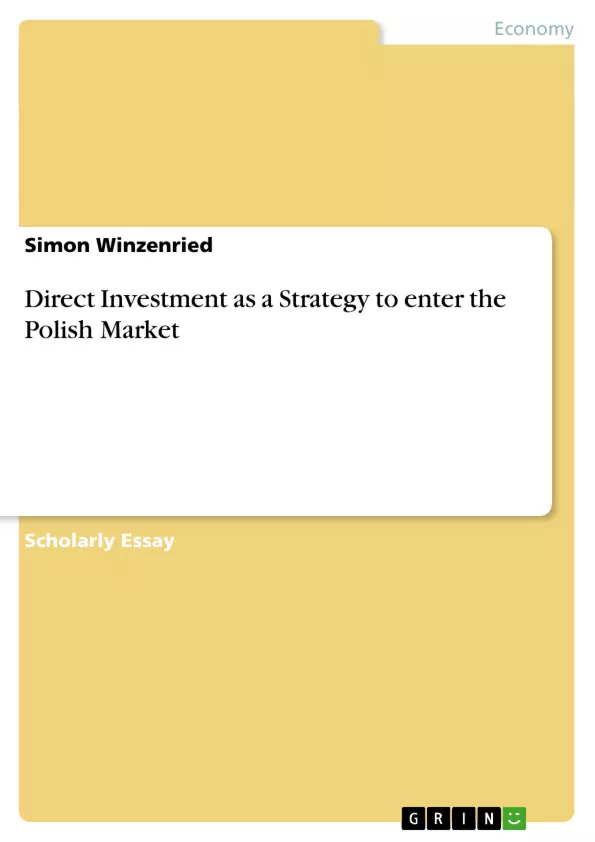One year after joining the European Union Poland regains its reputation as one of the top investment locations in Europe. Fierce competition for foreign direct investment (FDI) with rivals such as Slovakia and Czech Republic has dumped direct investment in the country in the recent years. Frequently changing governments, a network of disputable roads and inconsistent tax laws further contributed to a negative development of FDI in Poland (Cienski 2005).
However last year’s empowerment of a “technocratic government” that replaces a “corruption-ridden” political class is the impetus for a new investor friendly policy. This positive development is underpinned by the victory of Lech Kaczynski in October’s (2005) presidential elections. Positioned centre-right Kaczynski is supposed to enhance Poland’s attractiveness for investors with reduced taxes and bureaucratic burdens and is to approach prospect investors with tailor made offers (Cienski 2005).
A new corporate flat tax of 19%, Poland’s return to strong economic growth (5,4 % in 2004) and its membership in the European Union are just some factors that explain Poland’s attractiveness for investments from abroad (Earnest&Young 2005, p. 14). Wages are about a fifth of European average income (Spiro 2004) and labour productivity has risen significantly by 9,2 % in the past two years 2004 (PAIiIz 2005). This development puts the lid on a successful transition process from a socialist country with a centrally planned economy to a modern western democracy with a market-oriented economic system. This significant progress in transition is the basis for Poland’s appeal to foreign companies and is a key determinant in the decision for a direct investment (Figure 1; Mueschen 1998, p. 303).
Inhaltsverzeichnis (Table of Contents)
- 1. INTRODUCTION
- 2. FOREIGN DIRECT INVESTMENT
- 2.1. FOREIGN DIRECT INVESTMENT - A DEFINTION
- 2.2. FACTORS OF INFLUENCE ON FOREIGN DIRECT INVESTMENT DECISIONS
- 2.2.1. The Domestic Market
- 2.2.2. Corporate Factors
- 2.2.3. The Target Market
- 2.3. FOREIGN DIRECT INVESTMENT IN POLAND
- 2.3.1. Poland regains Reputation as top Investment Zone
- 2.3.2. Modes of Foreign Direct Investment – Greenfield is on the Rise
- 2.3.3. Main Countries Investing - France takes the Lead
- 3. FACTORS OF INFLUENCE ON FOREIGN DIRECT INVESTMENT IN POLAND
- 3.1. FACTORS OF PRODUCTION
- 3.1.1. Human Capital - high Quality, low Costs
- 3.1.2. Knowledge Resources - top in IT and Mathematics
- 3.1.3. Material Resources - highly available and competitive
- 3.2. POLITICAL & LEGAL FACTORS
- 3.2.1. Political Situation - a long Way to Stability
- 3.2.2. The Constitution - Progress and Stability
- 3.2.3. Corruption - Poland's Vice
- 3.2.4. Infrastructure – Poland's weak Point
- 3.2.5. Economic Development - strong but vulnerable
- 3.2.6. Tax & Investment Incentives – sound Business Promotion
- 3.3. DEMAND SITUATION
- 3.4. FACTORS OF INFLUENCE AND MARKET ENTRY STRATEGY
- 3.1. FACTORS OF PRODUCTION
- 4. CONCLUSION
Zielsetzung und Themenschwerpunkte (Objectives and Key Themes)
The purpose of this paper is to analyse recent foreign direct investment (FDI) developments in Poland and to evaluate the key factors influencing companies' market entry decisions in this country. The paper examines three main pillars: progress in transition, factors of production, and market potential.
- Poland's transition from a socialist economy to a market-oriented system
- Factors of production, including human capital, knowledge resources, and material resources
- Political and legal factors, such as political stability, legislative consistency, and infrastructure development
- Market potential and demand situation in Poland
- Market entry strategies and their influence on foreign direct investment decisions
Zusammenfassung der Kapitel (Chapter Summaries)
- Introduction: The paper introduces the context of FDI in Poland, highlighting the country's recent efforts to attract investment after a period of decline. It discusses the factors contributing to Poland's attractiveness, including its membership in the European Union, strong economic growth, and low wages. The paper emphasizes the importance of the transition process from a centrally planned economy to a market-oriented system, which is a key determinant for foreign investment.
- Foreign Direct Investment: This chapter defines foreign direct investment (FDI) as a private investment abroad that results in ownership rights, granting investors direct influence on the capital recipient's business processes. The chapter also discusses the different types of FDI, including greenfield investment and merger & acquisition (M&A).
- Factors of Influence on Foreign Direct Investment in Poland: This chapter examines the key factors influencing FDI decisions in Poland, focusing on the three pillars mentioned above: factors of production, political and legal factors, and demand situation. It explores the availability and quality of human capital, knowledge resources, and material resources, as well as the country's political and economic stability, legislative consistency, infrastructure development, and market potential.
Schlüsselwörter (Keywords)
The paper focuses on foreign direct investment (FDI) in Poland, exploring the key factors influencing market entry decisions. It examines factors of production, political and legal factors, market potential, and the transition process from a socialist economy to a market-oriented system. The paper also discusses different types of FDI, including greenfield investment and merger & acquisition (M&A).
- Quote paper
- Simon Winzenried (Author), 2005, Direct Investment as a Strategy to enter the Polish Market, Munich, GRIN Verlag, https://www.grin.com/document/52855



